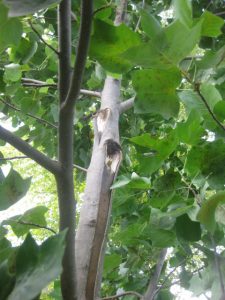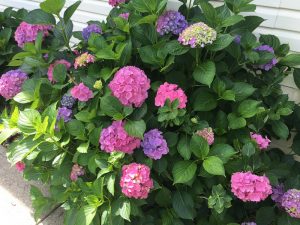Large wounds in tuliptrees not likely to heal
Q) I’ve attached a photo of one of my trees. I’m concerned that the tree will not heal, and if it does will be too weakened. Also, you gave me a contact for a state arborist last time we visited. I have lost that info.
– G.F., Jeffersonville, Indiana
A) Looks like perhaps this was storm-related damage? Tuliptrees are somewhat weak-wooded and can be susceptible to limb breakage during strong storms. While it is difficult to assess from just the photos, I don’t think there is much you can do for the wounds that are already there. Wound dressing and tree paint are NOT recommended; they don’t help, and they can interfere with the tree’s natural wound closure process. These wounds are large enough that the tree might never be able to fully close that tissue and so those areas do remain a susceptible point for further decay and disease. Trees can survive for many years with such damage, but you may want to consult a certified arborist to determine if the tree poses a hazard. Purdue Forestry and Natural Resources Department has an excellent publication on hiring a professional arborist, see https://www.extension.purdue.edu/extmedia/fnr/fnr-faq-13-w.pdf. You can search for a certified arborist in your area by visiting www.treesaregood.org/findanarborist.
Q) I know you’ve addressed the ever-frustrating and puzzling hydrangeas that refuse to bloom, but I’m reaching out as a final attempt to solve the mystery of my disappointing nonbloomers. I’ve done everything I can think of, including fertilizing, researching optimum soil and light conditions, careful pruning of only old blooms late in the spring, covering them with towels to protect them from late frosts and waiting patiently – OK, maybe not so patiently but waiting nonetheless for seven years! They were supposed to bloom on new and old wood throughout the summer months. They were called Endless Summer I believe. I planted about 12 of them. Three are planted on the north side of my house against the garage wall. These three are the only ones that ever bloom. I’ll include a picture of these. All the others I planted on the south side of my house. They aren’t up against the house like the others. They get morning sun and some afternoon sun, but some shade in midday. Their leaves are big, green and healthy-looking for the most part. A couple have a few lighter yellow leaves. Overall, the plants are green and healthy-looking but never bloom. I’m sorry I don’t have any pics of these. I only took a few this morning of the ones on the other side of the house that actually bloom. What do I need to do? What might be the problem? I appreciate any insight or advice you may have to offer! Thank so much for your help! – S.D., Bloomfield, Indiana
A) Sadly, many Indiana gardeners find ‘Endless Summer’ failing to deliver summerlong blooms, myself included. In most areas of the state, they will die back to the ground but should be able to bloom on the new growth by mid- to late summer. Mine has never performed well over 10 years, at most one or two bloom clusters per year. I have mine planted in morning sun, afternoon dappled shade, and though it dies back to the ground each year the new growth is healthy, green and robust. This year I’ve had one flower cluster thus far. It could be that our hot summers are just too much for them, often wilting during hot afternoons even if the soil is moist.
Some Indiana gardeners do have good luck with their Endless Summer hydrangeas, but I have not been able to determine that they do anything different from those of us that have less success. Some advocate covering the plants with mulch for winter; others have had good results with applications of blooming plant fertilizer. In late winter or early spring, you can cut the dead stems back to live buds or to the ground and let the new twigs emerge from lower on the base of the plant.
In your case, seems that the three you have planted on the north side of the wall are performing quite well – I envy your success! Endless Summer was the first selection of H. macrophylla that blooms on new wood. There are some newer selections of re-blooming H. macrophylla on the market, including Let’s Dance, Forever and Ever and Twist-n-Shout. Perhaps it is time to try one of those?

